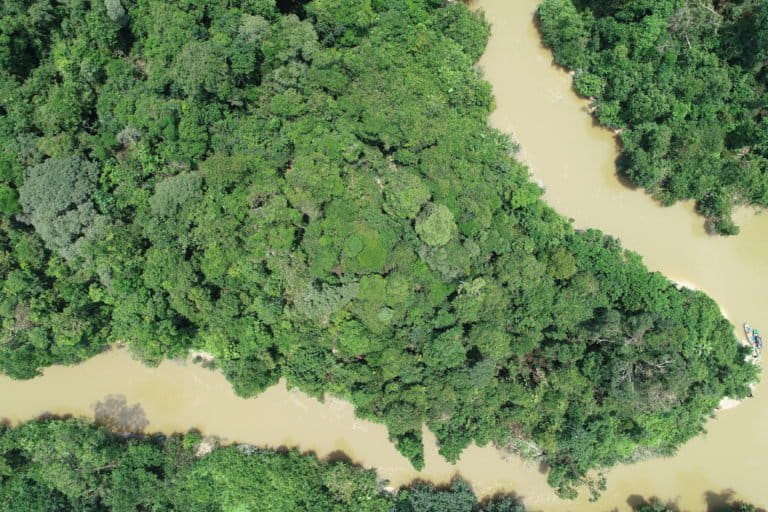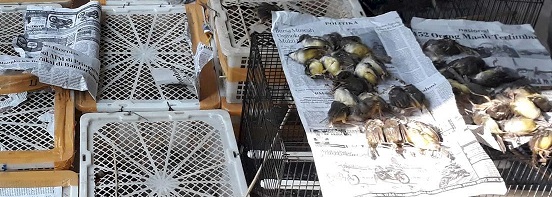- A decade of protection and natural regeneration of tropical forests has helped bird populations increase in the southern lowlands of Indonesia’s Sumatra Island, a new study says.
- However, it adds that continued wild trapping is preventing the reforestation effort from achieving its greatest results.
- The Harapan Forest, which straddles the provinces of Jambi and South Sumatra, in 2007 became the site of Indonesia’s first ecosystem restoration concession to recover biodiversity in the region after commercial selective logging ceased in 2005.
- Since 2004, Indonesia has awarded 16 licenses for ecosystem restoration concessions, including for the Harapan Forest, covering an area of 623,075 hectares (1.54 million acres) in Sumatra and Borneo, according to 2018 government data.
JAKARTA — A decade of protection and natural regeneration of tropical forests has helped bird populations increase in the southern lowlands of Indonesia’s Sumatra Island, but continued wild trapping by poachers is preventing a speedier recovery, a new study shows.
Wild populations of birds at the Harapan flagship tropical forest restoration site increased over the course of a decade due to protection and natural regeneration efforts, according to the paper published in a recent issue of the journal Biological Conservation. But the authors also calculated that the population recovery wasn’t achieving its full potential because of the persistence of trapping and hunting to supply Indonesia’s controversial bird trade.
“Although previous research … addressed the impact of trade-driven bird trapping on wild bird populations, our study is the first to demonstrate the inhibitory effect of wildlife trade on forest reforestation,” study lead author H. S. Sathya Chandra Sagar, a Ph.D. student at the Department of Forest and Wildlife Ecology at the University of Wisconsin–Madison, told Mongabay in an email.
The Harapan Forest, which straddles the provinces of Jambi and South Sumatra, in 2007 became the site of Indonesia’s first ecosystem restoration concession to recover biodiversity in the region after commercial selective logging ceased in 2005. The reforestation project, jointly managed by a consortium of conservation organizations with heavy financial investment and on-the-ground presence, has since shown signs of recovery through natural regeneration and active tree planting, despite pressures like illegal logging, encroachment and wildfires that have persisted over the years.
The recent study sampled bird surveys taken in 2009-2011 and 2018, and processed forest coverage changes collected from satellite laser imagery. The researchers collected specimens of 122 bird species for the abundance modeling, and found that 45.1% of species showed a notable population increase during the study period. They also found that the average forest canopy height increased across the areas in Harapan that didn’t experience significant fire, degradation or deforestation over the study period.
The authors wrote that those findings were encouraging, considering the investment put into the Harapan reforestation efforts: the total funds that have gone into the project amount to $20 million, with an annual operating cost of up to $2.5 million. Since 2004, Indonesia has awarded 16 licenses for ecosystem restoration concessions, including in the Harapan Forest, covering an area of 623,075 hectares (1.54 million acres) in Sumatra and Borneo, according to 2018 government data. These licenses allow the holders to restore previously logged forests for periods of 60-100 years, and once “ecosystem balance” has been attained, they may then opt to harvest timber or set up ecotourism sites or establish ecosystem services use.
However, the paper also found that at least 16.2% of the 122 bird species faced intensified trapping pressure, which the authors noted as dampening the full success of the forest recovery efforts. This is because many bird species play key roles in the regeneration and functioning of forest ecosystems, such as seed dispersal, the researchers wrote.
“Our findings demonstrate the potential of forest protection and regeneration in recovering Southeast Asia’s avian diversity but highlight the urgency of tackling the intensifying threat of pet trade,” the paper read.


The keeping of songbirds is a popular pastime in Indonesia, especially among the Javanese, who see it as signifying status and promoting peace of mind. The activity has expanded beyond Java, thanks largely to the government’s transmigration program that relocated residents of the densely populated island to other parts of the country, including to Sumatra, allowing birdkeeping to take root in those regions.
Previous studies on the bird trade have highlighted urban markets in Java and Sumatra. A 2005 report estimated that an average of 614,180 native songbirds were trapped and traded annually throughout the two islands.
Songbirds are also prized for use in contests, which have spawned thriving networks of clubs, online forums and blogs. President Joko Widodo, himself a noted songbird collector and fan, said in March 2018 that birdkeeping contributed an estimated 1.7 trillion rupiah ($114 million) to the economy.
Sagar said he understood the importance of keeping birds as pets and for singing competitions in certain Indonesian cultures, but added that the harvesting of birds from the wild for the pet trade is currently an unsustainable business model and counterintuitive in the long run as declines driven by trapping could lead to cascading ecological impacts that slow down the time these concessions reach ecosystem balance.
Indonesia is home to the largest number of threatened bird species in Asia, according to TRAFFIC, a wildlife trade monitoring group. The Southeast Asian country has a protected species list that bans the capture or trade of threatened wildlife. Anyone convicted of catching protected species in the wild faces up to five years in prison and fines of 100 million rupiah ($6,800) under the 1990 Conservation Act.
But the government also allows a quota for registered breeding facilities to catch a protected species in the wild for captive-breeding purposes. These facilities can then sell the offspring, which, crucially, are not designated as protected.
The main problem, conservationists say, is that many captive breeders don’t register themselves or the songbirds they breed, rendering it increasingly likely that the birds they purport to have bred were actually captured in the wild and laundered through their facilities. Inflated quotas for breeding animals in Indonesia’s commercial conservation facilities appear to be fueling the illegal wildlife trade, according to TRAFFIC.
In addition, collectors prefer wild-caught birds, which they believe have superior song quality over captive-bred ones, TRAFFIC said. The premium they’re willing to pay gives traders plenty of incentive to stock wild-caught birds rather than go to the trouble of breeding birds from the same species.

Sagar suggested breeding centers diversify the number of species they breed, to cater to collectors who would otherwise opt for wild-caught birds. He also said restoration concessions could employ more local community members and bird trappers, where possible, in restoration and as bird-watching guides, which would give them an economic incentive to forgo trapping and to engage in conservation.
Sagar said restoration projects should also phase out unnecessary access roads and regularly monitor them even after abandonment as active habitat restoration could increase accessibility to remote parts of the area, which could open up areas to hunting.
The Indonesian government has granted permission to a coal company to build a road that would cut through the Harapan Forest, which is home to 1,350 known wildlife species and counting, including the critically endangered Sumatran tiger (Panthera tigris sondaica) and Sumatran elephant (Elephas maximus sumatranus).
“We need to better understand and address the underlying drivers of wild bird trapping through a collaborative, multi-stakeholder approach, such as that showcased by the Asian Songbird Trade Specialist Group,” Sagar said.
Citation:
Sagar, H. S. S. C., Gilroy, J. J., Swinfield, T., Burivalova, Z., Yong, D. L., Gemita, E., … Hua, F. (2023). Avifauna recovers faster in areas less accessible to trapping in regenerating tropical forests. Biological Conservation, 279. doi:10.1016/j.biocon.2023.109901
Basten Gokkon is a senior staff writer for Indonesia at Mongabay. Find him on Twitter @bgokkon.
See related from this reporter:
Indonesia approves coal road project through forest that hosts tigers, elephants
FEEDBACK: Use this form to send a message to the author of this post. If you want to post a public comment, you can do that at the bottom of the page.
This story first appeared on Mongabay
South Africa Today – Environment
This article is licensed under a Creative Commons Attribution-NoDerivatives 4.0 International License.
You may republish this article, so long as you credit the authors and Mongabay, and do not change the text. Please include a link back to the original article.











